If you Want to make elderflower wine this year 2008 you must act now 17/06/08 if you delay you will miss the flowers which will soon have fallen from the staymen, leaving just the small green pin like head which will soon form into the berries
All of the basic procedures we used with the rhubarb & White grape apply to this wine.
Requirements to make five gallons
1. 12 to 15 med to large elder flower heads, pick fresh and taking precautions to ensure you only pick the ones that you like the smell of. Elder can vary from real stinking to sweet smelling and it is of course the later one that you are looking for. Make sure before picking that they are free of black fly and other insects. Avoid picking unless required, remember they are our Birds Autumn food!
2. 9 litres of Pure White Grape Juice.
3 5 Kg of granulated sugar.
4. 1 Kg of washed Sultanas .
5. campden tablets .
6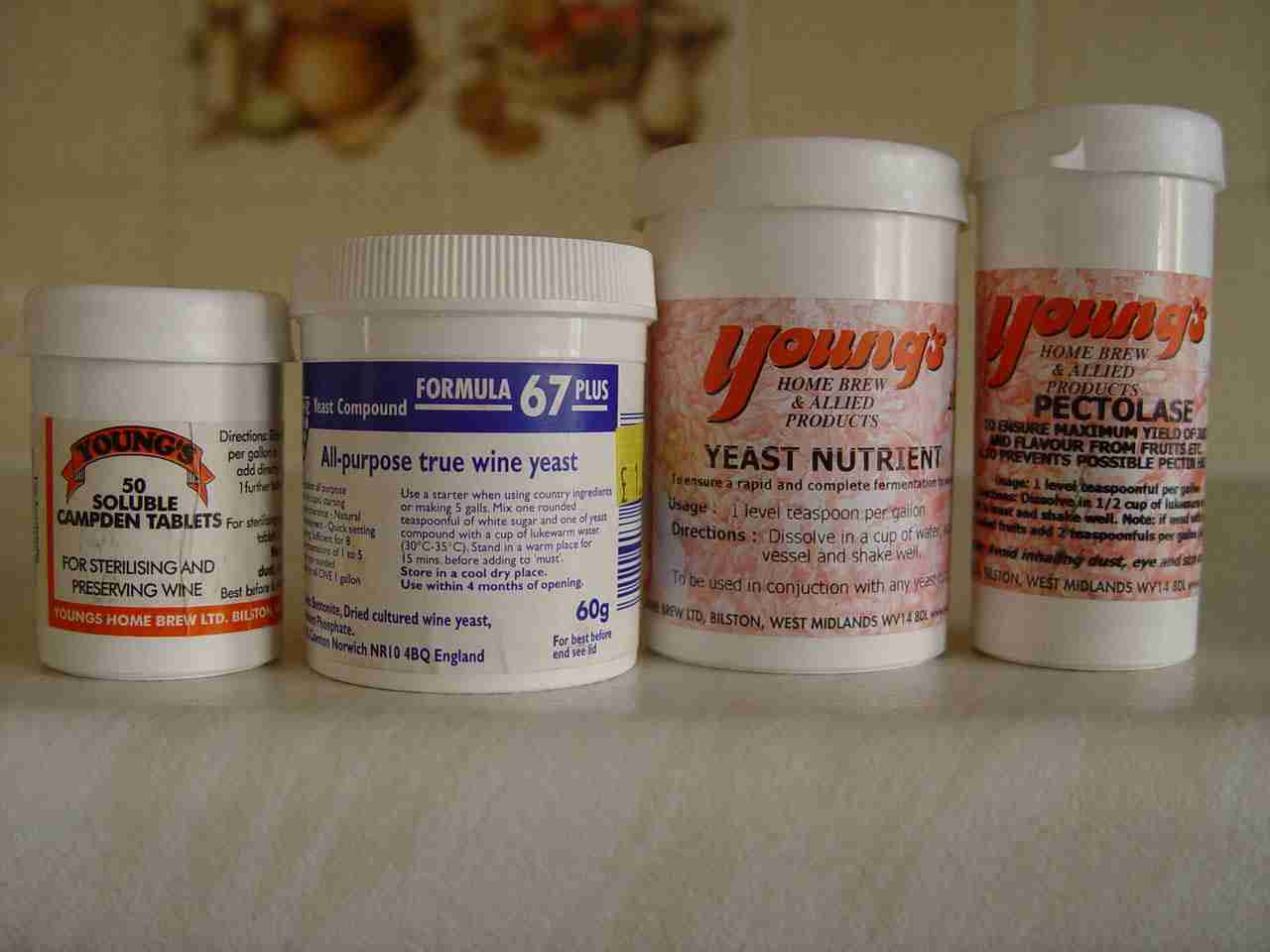 Pectolase
Pectolase
7. Yeast nutrient
8. Grape Tannin
9 Two lemons or Citric Acid.
Method
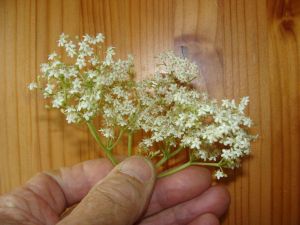
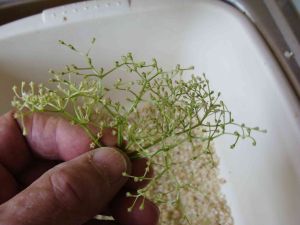 Knock/brush off as many of the flower heads from the elderflower bunches as possible if they are in full bloom most of the heads will fall off the stamen. Trim off any remaining heads keeping any stalk to an absolute minimum place into a muslin bag and secure the top. Place into a suitable container and pour boiling water over the bag until submerged, we will be adding water to the wine so the quantity does not matter at this stage, one litre will be fine.
If the smell is strong don't worry, remember this is a concentration of the smell and colour that has been purged from the flowers, which will be diluted in our wine mixture.
Knock/brush off as many of the flower heads from the elderflower bunches as possible if they are in full bloom most of the heads will fall off the stamen. Trim off any remaining heads keeping any stalk to an absolute minimum place into a muslin bag and secure the top. Place into a suitable container and pour boiling water over the bag until submerged, we will be adding water to the wine so the quantity does not matter at this stage, one litre will be fine.
If the smell is strong don't worry, remember this is a concentration of the smell and colour that has been purged from the flowers, which will be diluted in our wine mixture.
Add 1 tsp of pectolase sprinkle into the water and stir.
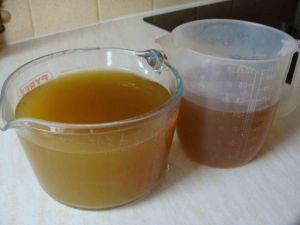
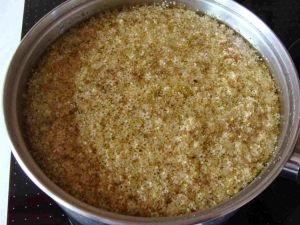
This year I have avioded getting any green of the stems mixed with the florets, this I feel will improve the wine and the eldersmell will be slightly less than with previous batches of wine,
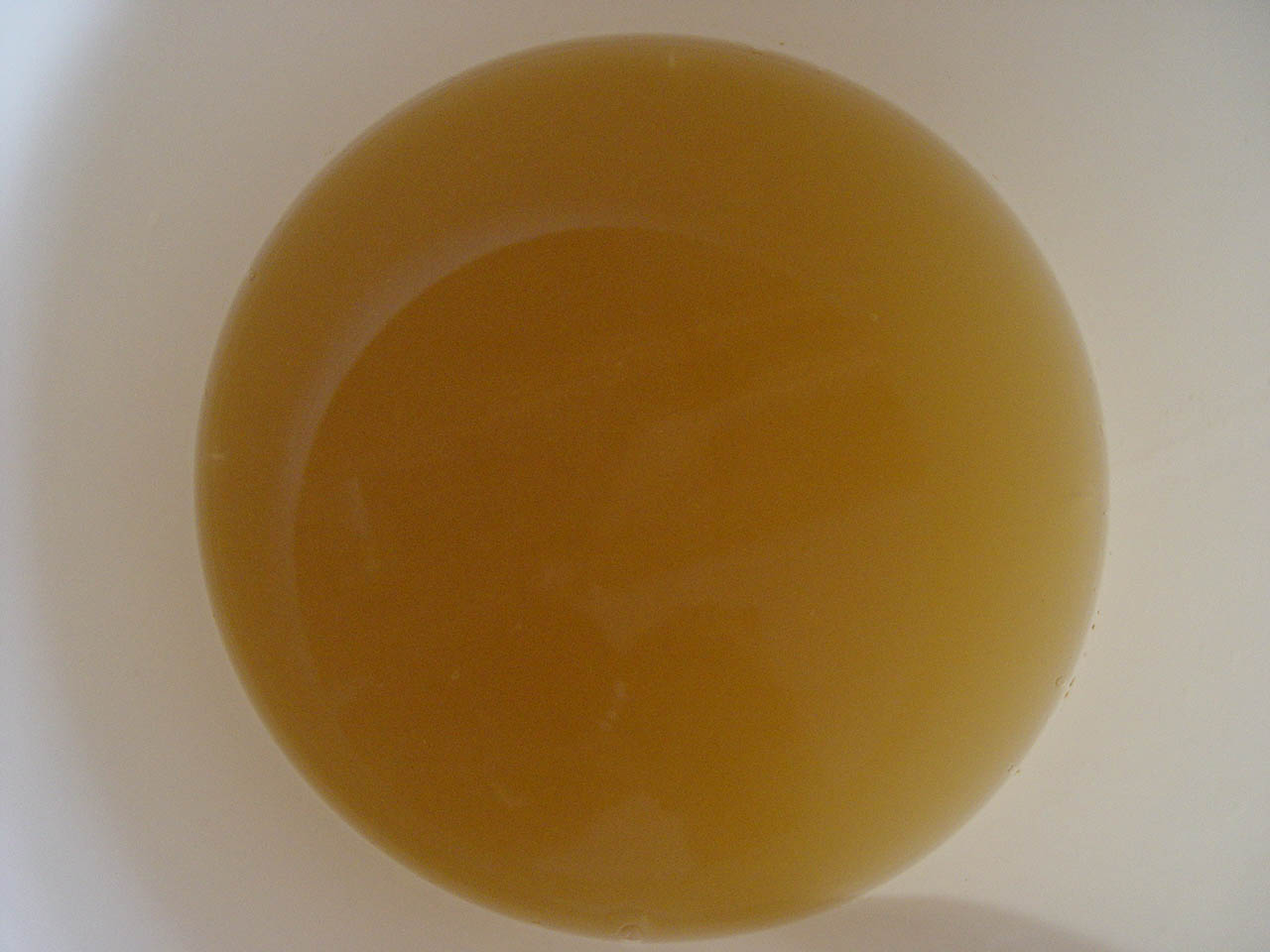 Bruise the flowers until the water colours, this can be done several times to force the flavour and colour from the flower petals, the water will become a yellow colour and may also be strong smelling. The colour of the concentrated mixture is shown in the photo on the right .
Bruise the flowers until the water colours, this can be done several times to force the flavour and colour from the flower petals, the water will become a yellow colour and may also be strong smelling. The colour of the concentrated mixture is shown in the photo on the right .
Remove the bag containing the flowers, squeeze as much liquid as possible from the bag, discard the used petals. Place the resulting liquid into a suitable container.
Add the grape juice.
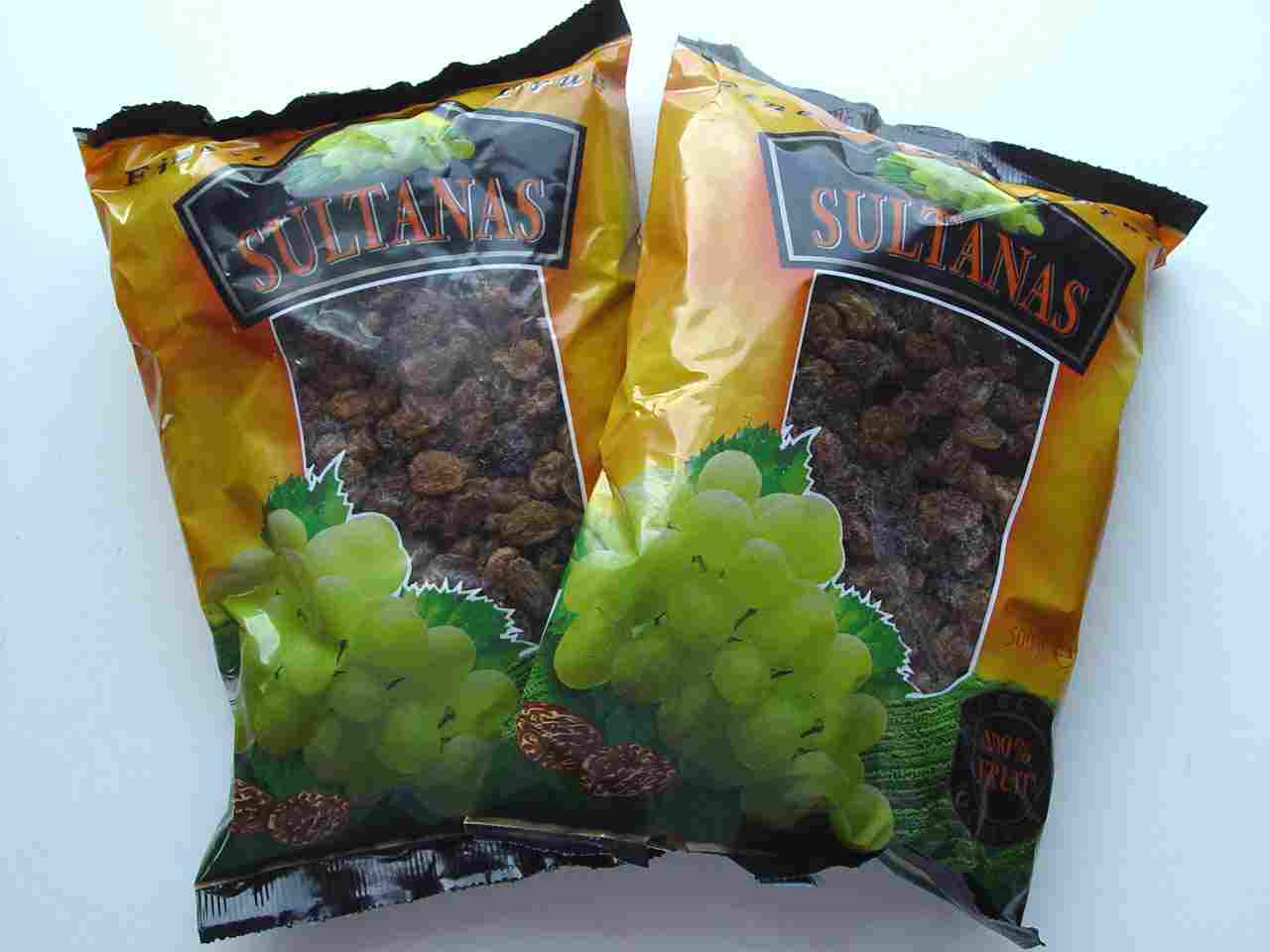
You can put the sultanas in whole if your wish but remember the aim is to get as much flavour from them as possible, we won't be removing these frofor some time anyway so the currants will become swollen with the liquid allowing the flavour to form part of our wine mixture Now chop your sultanas, if using a food processor add a small quantity of water, when well chopped add to your mixture.
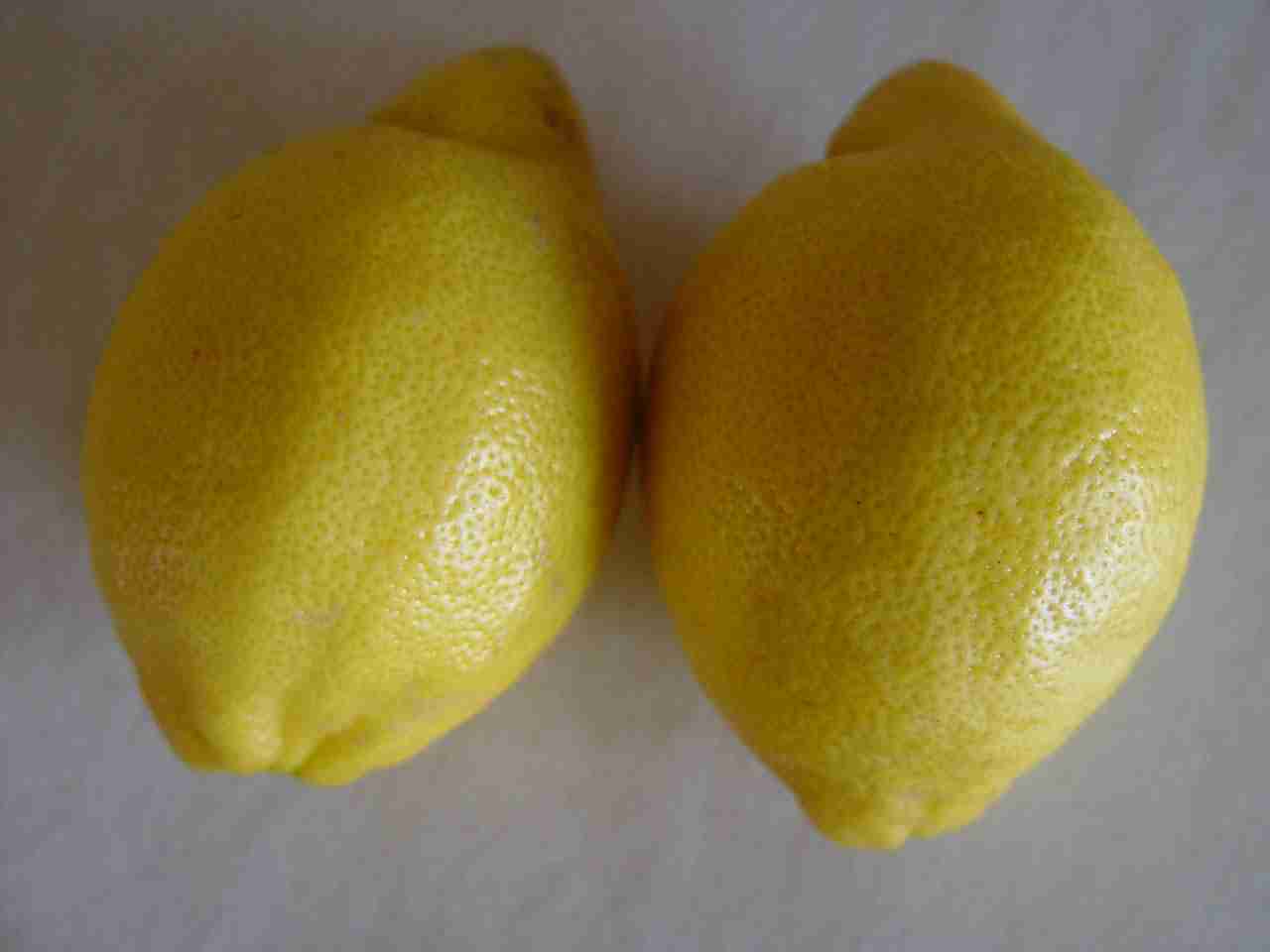 Cut and squeeze the juice from two medium lemons and add to your mixture.
Cut and squeeze the juice from two medium lemons and add to your mixture.
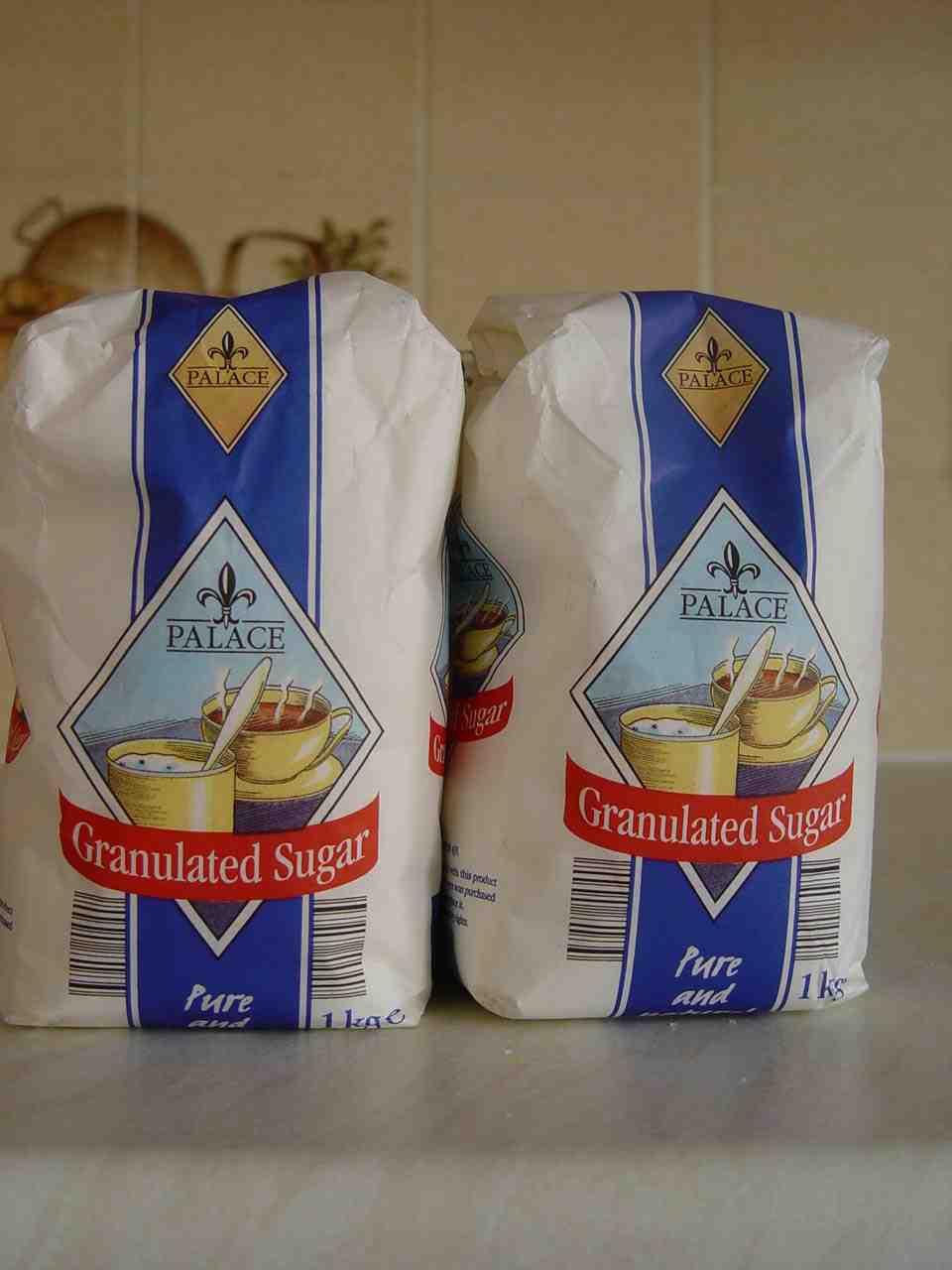
Dissolve the 5kg of sugar in the minimum quantity of water, add 95% to the mixture. Retain the remaining 5% for sweetening further if required. Stir well, you may well have to dissolve the sugar in two parts, take care when pouring hot sugar syrup into your mixture.
Now add cold clean water to bring the quantity of liquid up to say a litre below your maximum mark on your Bucket or Barrel, this is to allow for adding more sugar syrup if required, See page one.
Take 2 tsp of yeast nutrient mix with a small amount of warm water, when dissolved add to the mixture, more can be added later if required.
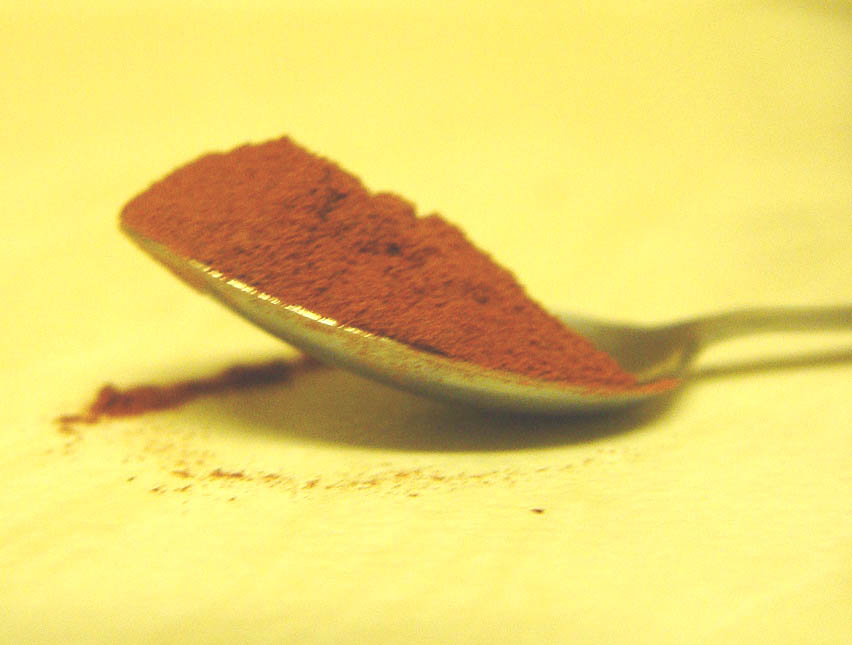 Add 1 tsp of grape tannin.
Add 1 tsp of grape tannin.
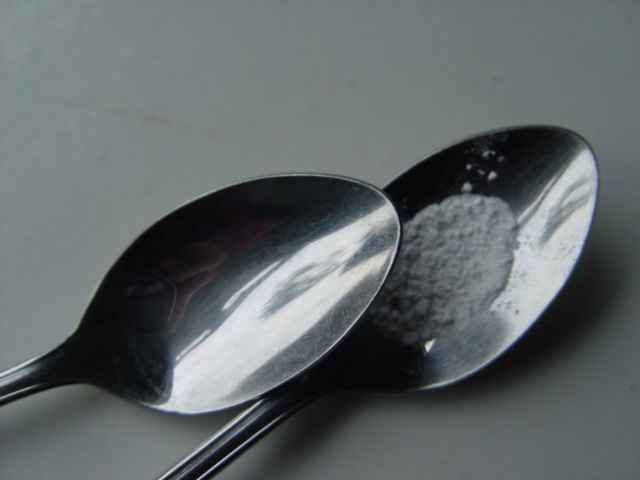
Crush 3 campden tablets and add to your mixture, stir well.
Using your Hydrometer and vessel, measure the (S.G.) specific gravity, like our earlier wine we are looking for a reading of 1085 min, if below take a small amount of the reserve sugar syrup and keep adding it until the correct reading is reached, remember to stir well between the tests.
When the correct reading is reached take approx 1 dessert spoonful and place in a suitable container, at this stage the mixture should be at about blood temperature, cool if required.
When you have got the bulk mixture with a S.G. between 1085-1090 cover with a clean cloth and seal the container as mentioned earlier.
Add a small amount of luke warm water to the sample you took from the bulk mixture and stir, at this stage you want approx 150ml
Add 1 heaped tsp of Wine yeast to your sample this will become your Yeast Starter for your wine,
Stir well and cover. Place in a warm place and allow the fermentation process to begin
After approx 1 hour you should see the yeast working on your dilute mixture. Take a further 100ml of your bulk mixture and add it to your starter, add a similar amount of warm water, allow to work over night. Ensure the container you use is large enough to accommodate the increase in the volume of liquid as the yeast continues to work, a glass measuring jug is ideal.
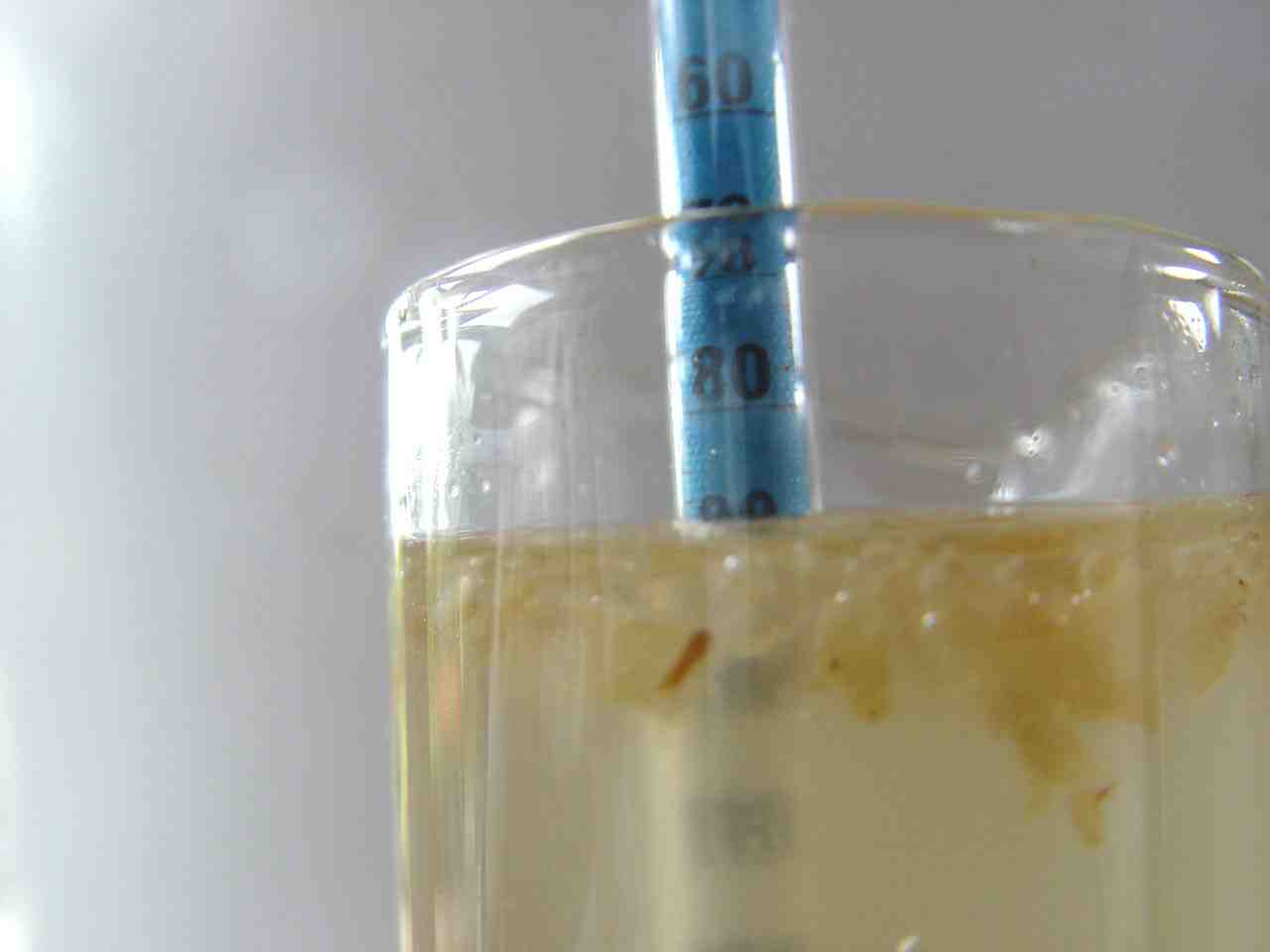 The following day you should see your yeast working well, if you do not see any action in the container then listen and you will hear the yeast working on the liquid. If the yeast looks dormant and you see a white/grey layer at the bottom of the container and the starter has been kept warm, then do not use, but start again if possible using a different batch of yeast. Yeast does have a life span and unless stored in good conditions will fail to work when required.
The following day you should see your yeast working well, if you do not see any action in the container then listen and you will hear the yeast working on the liquid. If the yeast looks dormant and you see a white/grey layer at the bottom of the container and the starter has been kept warm, then do not use, but start again if possible using a different batch of yeast. Yeast does have a life span and unless stored in good conditions will fail to work when required.
After you have successfully added a working yeast to your mixture, take another reading on the hydrometer, you may well find that the reading has increased . This will be due to the natural sugars in the sultanas being absorbed into the wine mixture. As is shown in the photo my reading went from 1087 to 1089. This is not a problem and the yeast will cope with the small amount of extra sugar. Remember to label your wine mixture with all the relevant details and record the hydrometer reading.
Note Elders are in bloom now if you want to make this wine get your flowers in the next week or so, it is appreciated that up North things are usually a bit later coming into bloom but keep an eye open or you will miss your chance until next year.
10/06/04 Having made the point about collecting your elder flowers I must say that I have never seen so many elder flowers the elder trees appear to be completely white with bloom, remember as suggested earlier not all will have the right smell for making wine from so choose wisely. The White grape and elder flower started last week already has a specific gravity of 110 having dropped 76 on the scale this is due to the temperature along with the balanced ingredients which are still working well, this evening I have passed the partially completed wine through a course sieve to remove the chopped currents, like our earlier wine I am now left with five gallons of liquid that will soon become our finished elder flower and white Grape wine.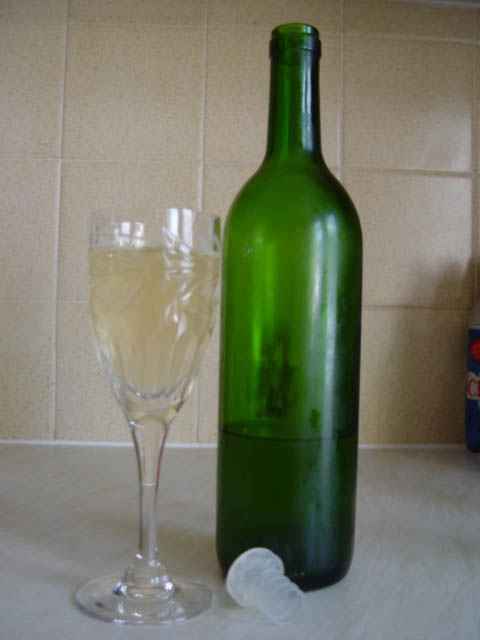
An early taste of a small amount of this wine by Melvyn the Manager of the Johnson Homewine Supplies Ltd, http://brewahome.co.uk as well as my wife and self indicate that is a very promising wine. A small amount of caster sugar was added to the sample to bring the SG to 0995 The wine started out with an SG of 1085, sugar to increase the the SG to 1095 has been added as the yeast has demanded more sugar syrup, the FSG is now 986 which gives us a wine of 15%, the highest alcohol content of any wine I have made. The method of feeding sugar syrup to the yeast was covered earlier.
In fact so promising is this wine that I couldn't resist gathering extra elder flowers, and following our earlier process removed the flower heads, but instead of starting another batch of wine have frozen the resulting infusion which intend using at a later date in the making of more wine, when this years flowers are turning to berries, another useful ingredient for the wine maker. I'm sure it will work as all the flavour of the elder flower is retained within the ice cubes.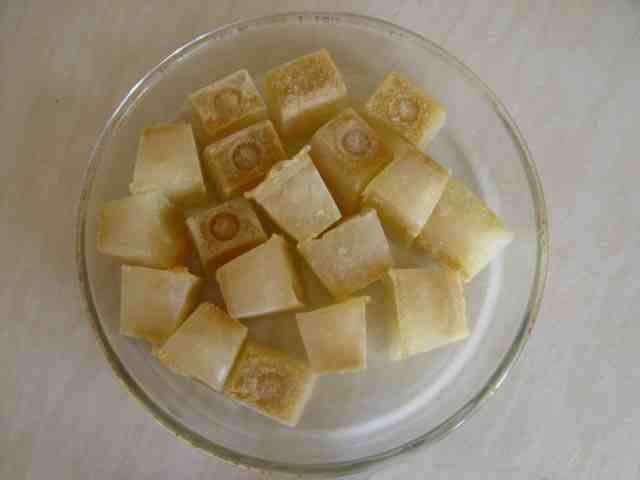
Since my last entry 17 06 04 and being so pleased with the earlier batch of Elderflower wine I have made a further 5 gallons using the elderflower ice cubes I mentioned, I added the liquid from the frozen elderflower/ice cubes to the white grape juice and everything else was done the same as with the earlier batch. On my return from Scotland on the 7th July, the second batch had finished and cleared so I simply added the fermentation stopper and 3 crushed campden tablets, filtered it and being aware that it was drier than the first batch made blended the two batches together. I then sweetened the lot with castor sugar to achieve a reading of 0995 on the hydrometer having previously decided that that was the degree of sweetness we both preferred, with castor sugar because it dissolves easily and avoids adding any further water. We now have 10 gallons in demijohns the equivalent of 60 x 75 litre bottles, that's a lot I hear you say! Be assured it will all be drunk in its turn and as the years pass! Remember you may like your wine drier or sweeter so add sweetener to suite yours taste, take great care not to over sweeten.
Remember if you want a special bottle sweetened then decant it add the castor sugar required. If you are proud of your home made label you may wish to return it to the bottle, Remember also that this wine is best chilled. Alternatively you could place it in your frosted cut glass wine decanter, available in most charity shops for a mere song!
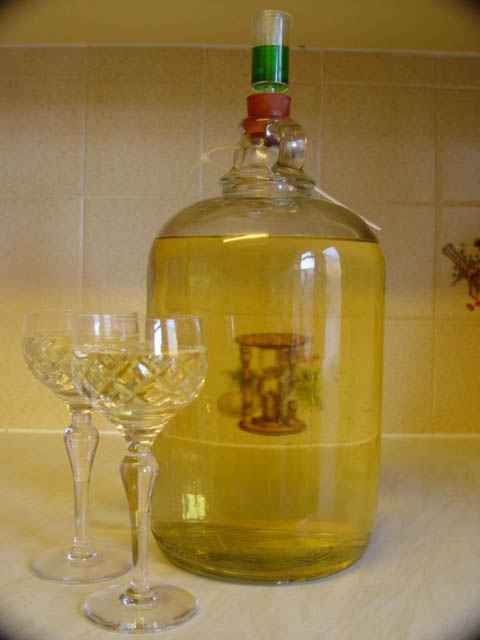
The finished product, cleared using finings, now ready to go on the shelf to age, early indication are that it will need sweetening to bring the S.G up to approx 0995, it is currently at 0986, depending of course on your taste. remember that substitute sweeteners do not raise the SG but do sweeten the wine, so check at very regular intervals and add your sweetener in very small quantities or you will spoil what is going to be a good wine.
This wine from start to finish took less than a one Month
Next
Return to menues
Back to Homepage
Requirements to make five gallons
1. 12 to 15 med to large elder flower heads, pick fresh and taking precautions to ensure you only pick the ones that you like the smell of. Elder can vary from real stinking to sweet smelling and it is of course the later one that you are looking for. Make sure before picking that they are free of black fly and other insects. Avoid picking unless required, remember they are our Birds Autumn food!
2. 9 litres of Pure White Grape Juice.
3 5 Kg of granulated sugar.
4. 1 Kg of washed Sultanas .
5. campden tablets .
6
7. Yeast nutrient
8. Grape Tannin
9 Two lemons or Citric Acid.
Method
Add 1 tsp of pectolase sprinkle into the water and stir.
This year I have avioded getting any green of the stems mixed with the florets, this I feel will improve the wine and the eldersmell will be slightly less than with previous batches of wine,
Remove the bag containing the flowers, squeeze as much liquid as possible from the bag, discard the used petals. Place the resulting liquid into a suitable container.
Add the grape juice.
You can put the sultanas in whole if your wish but remember the aim is to get as much flavour from them as possible, we won't be removing these frofor some time anyway so the currants will become swollen with the liquid allowing the flavour to form part of our wine mixture Now chop your sultanas, if using a food processor add a small quantity of water, when well chopped add to your mixture.
Dissolve the 5kg of sugar in the minimum quantity of water, add 95% to the mixture. Retain the remaining 5% for sweetening further if required. Stir well, you may well have to dissolve the sugar in two parts, take care when pouring hot sugar syrup into your mixture.
Now add cold clean water to bring the quantity of liquid up to say a litre below your maximum mark on your Bucket or Barrel, this is to allow for adding more sugar syrup if required, See page one.
Take 2 tsp of yeast nutrient mix with a small amount of warm water, when dissolved add to the mixture, more can be added later if required.
Crush 3 campden tablets and add to your mixture, stir well.
Using your Hydrometer and vessel, measure the (S.G.) specific gravity, like our earlier wine we are looking for a reading of 1085 min, if below take a small amount of the reserve sugar syrup and keep adding it until the correct reading is reached, remember to stir well between the tests.
When the correct reading is reached take approx 1 dessert spoonful and place in a suitable container, at this stage the mixture should be at about blood temperature, cool if required.
When you have got the bulk mixture with a S.G. between 1085-1090 cover with a clean cloth and seal the container as mentioned earlier.
Add a small amount of luke warm water to the sample you took from the bulk mixture and stir, at this stage you want approx 150ml
Add 1 heaped tsp of Wine yeast to your sample this will become your Yeast Starter for your wine,
Stir well and cover. Place in a warm place and allow the fermentation process to begin
After approx 1 hour you should see the yeast working on your dilute mixture. Take a further 100ml of your bulk mixture and add it to your starter, add a similar amount of warm water, allow to work over night. Ensure the container you use is large enough to accommodate the increase in the volume of liquid as the yeast continues to work, a glass measuring jug is ideal.
After you have successfully added a working yeast to your mixture, take another reading on the hydrometer, you may well find that the reading has increased . This will be due to the natural sugars in the sultanas being absorbed into the wine mixture. As is shown in the photo my reading went from 1087 to 1089. This is not a problem and the yeast will cope with the small amount of extra sugar. Remember to label your wine mixture with all the relevant details and record the hydrometer reading.
Note Elders are in bloom now if you want to make this wine get your flowers in the next week or so, it is appreciated that up North things are usually a bit later coming into bloom but keep an eye open or you will miss your chance until next year.
10/06/04 Having made the point about collecting your elder flowers I must say that I have never seen so many elder flowers the elder trees appear to be completely white with bloom, remember as suggested earlier not all will have the right smell for making wine from so choose wisely. The White grape and elder flower started last week already has a specific gravity of 110 having dropped 76 on the scale this is due to the temperature along with the balanced ingredients which are still working well, this evening I have passed the partially completed wine through a course sieve to remove the chopped currents, like our earlier wine I am now left with five gallons of liquid that will soon become our finished elder flower and white Grape wine.

An early taste of a small amount of this wine by Melvyn the Manager of the Johnson Homewine Supplies Ltd, http://brewahome.co.uk as well as my wife and self indicate that is a very promising wine. A small amount of caster sugar was added to the sample to bring the SG to 0995 The wine started out with an SG of 1085, sugar to increase the the SG to 1095 has been added as the yeast has demanded more sugar syrup, the FSG is now 986 which gives us a wine of 15%, the highest alcohol content of any wine I have made. The method of feeding sugar syrup to the yeast was covered earlier.
In fact so promising is this wine that I couldn't resist gathering extra elder flowers, and following our earlier process removed the flower heads, but instead of starting another batch of wine have frozen the resulting infusion which intend using at a later date in the making of more wine, when this years flowers are turning to berries, another useful ingredient for the wine maker. I'm sure it will work as all the flavour of the elder flower is retained within the ice cubes.
Since my last entry 17 06 04 and being so pleased with the earlier batch of Elderflower wine I have made a further 5 gallons using the elderflower ice cubes I mentioned, I added the liquid from the frozen elderflower/ice cubes to the white grape juice and everything else was done the same as with the earlier batch. On my return from Scotland on the 7th July, the second batch had finished and cleared so I simply added the fermentation stopper and 3 crushed campden tablets, filtered it and being aware that it was drier than the first batch made blended the two batches together. I then sweetened the lot with castor sugar to achieve a reading of 0995 on the hydrometer having previously decided that that was the degree of sweetness we both preferred, with castor sugar because it dissolves easily and avoids adding any further water. We now have 10 gallons in demijohns the equivalent of 60 x 75 litre bottles, that's a lot I hear you say! Be assured it will all be drunk in its turn and as the years pass! Remember you may like your wine drier or sweeter so add sweetener to suite yours taste, take great care not to over sweeten.
Remember if you want a special bottle sweetened then decant it add the castor sugar required. If you are proud of your home made label you may wish to return it to the bottle, Remember also that this wine is best chilled. Alternatively you could place it in your frosted cut glass wine decanter, available in most charity shops for a mere song!
The finished product, cleared using finings, now ready to go on the shelf to age, early indication are that it will need sweetening to bring the S.G up to approx 0995, it is currently at 0986, depending of course on your taste. remember that substitute sweeteners do not raise the SG but do sweeten the wine, so check at very regular intervals and add your sweetener in very small quantities or you will spoil what is going to be a good wine.
This wine from start to finish took less than a one Month
Next
Return to menues
Back to Homepage